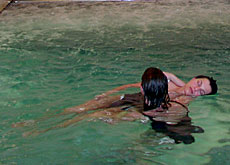
Dip into Baden’s historical spas

Switzerland's thermal baths were through the ages a centre for social, political and economic life.
The country is awash with natural springs and, as elsewhere in Europe, it was the Romans who first tapped into the thermal waters.
It’s been a while since a Swiss politician took his clothes off to sign a treaty with a foreign country.
News of such dealings in a thermal bath would make a real splash these days, but that was often the way it was done in the Middle Ages when Baden, with its 19 natural springs, was a hot spot of Swiss diplomacy.
Baden’s springs
The town’s baths lured the heads of the young Swiss confederation to hold their general meetings here in the 14th and 15th centuries.
“These meetings became popular… because they could combine business with pleasure,” Trudi Adank of Baden’s tourism office told me as we toured the ruins of its medieval spas.
“There they discussed politics, their aims and signed treaties with states around them.”
Roman idea
The Romans established a spa retreat aptly called “Acqua Helvetica” in Baden around the year five.
Not much is known about how the Romans used to bathe while ruling over the territory for the next 400 years since few records from the period have survived.
However, they laid the foundation for a bubbling spa industry. Baden’s fame as a spa spread across Europe, and it maintained its reputation into the 20th century.
Some one million litres of water bubble to the surface of Baden’s hot springs each day and the thermal waters here are said to be the richest in minerals in all of Switzerland.
Famous waters
Baden is proud of its laundry list of famous people who have taken a dip in its healing waters. Michel de Montaigne, the French Renaissance thinker, visited Baden’s spas on his many travels.
Switzerland’s Paracelsus also frequented Baden’s hot springs during the 1500s.
“One of the first guests who wrote home about how nice it was in Baden was Signore Boccio who served ten different Popes (during the early 1400s),” Adank recounts.
“And it was on his way to Constance in 1412 that Boccio discovered Baden. He loved it so much that he stayed here for months on his return journey. He thought that the girls of Baden were the most pretty he had ever seen.”
The appeal of Baden’s spas wavered little during the 18th and 19th centuries.
The Third Peace Treaty which ended the Spanish succession war was held here in 1714.
Afterwards, many people from across Europe and from all walks of life travelled to Baden. They brought their cooks, servants, followers, families and lovers.
Water for all
The poor also came. Pictures from the time show that the lower classes had their own baths and could apply to the local authorities to finance their annual cure.
Those with little means would also beg for money from the rich, who bathed separately.
Serious business
People would “take to the town’s waters” in the hope of being cured of illnesses like rheumatism, arthritis and gout, and would sit in the baths for up to eight hours – sometimes longer.
They would while away the time drinking, eating, doing business and making new acquaintances.
In fact, taking a cure was a major social activity where young men and women would come to meet each other, wrapping themselves in flimsy towels.
“The men especially liked to watch young women bathing because the towels would float on the surface of the water and then perhaps they could catch a glimpse of more intimate parts of that young body,” Adank laughs.
Superstition
The healing waters of the spas were also supposed to “open the wombs of infertile women”. There was a myth that if women dipped their feet into the biggest of Baden’s springs during a full moon, they would conceive.
“But historians think that if the women did fall pregnant, then it was probably thanks to one of the spa guardians!” Adank says.
Modest
Baden is now a modest place – more like a suburb of fast-paced Zurich. It can no longer compete with alpine spa towns like Bad Ragaz or Leukerbad, which are at the forefront of a transformation the Swiss spa industry is undergoing.
More than curing aches and pains, spas are harnessing water in a bid to improve physical appearances and emotional well-being.
This is part of a booming industry that has been renamed “wellness”, but which still depends on the hot springs discovered by the Romans 2,000 years ago.
swissinfo, Samantha Tonkin
The Romans first discovered many of Europe – including Switzerland’s hot springs 2,000 years ago.
They built thermal baths, including “Acqua Helvetica” in Baden in the year five.
Not much is known about the baths and how they were used until the Middle Ages when spas became an important meeting point for diplomats and villagers alike.
Rich and poor took to the waters each year to cure their illnesses.
The bubbling spa industry took a dive in the late 20th Century.

In compliance with the JTI standards
More: SWI swissinfo.ch certified by the Journalism Trust Initiative





























You can find an overview of ongoing debates with our journalists here . Please join us!
If you want to start a conversation about a topic raised in this article or want to report factual errors, email us at english@swissinfo.ch.